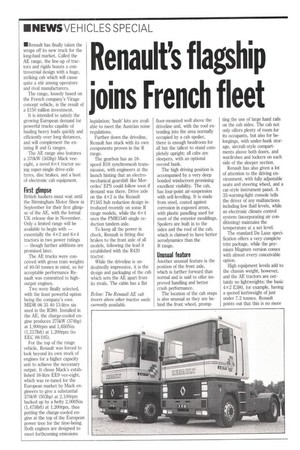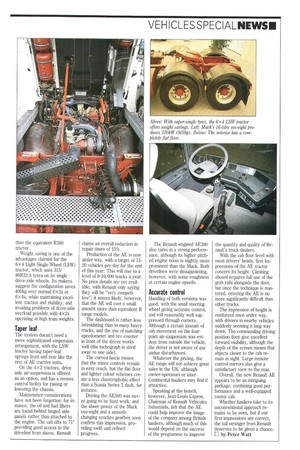Renault's flagship joins French fleet
Page 12

Page 13

If you've noticed an error in this article please click here to report it so we can fix it.
• Renault has finally taken the wraps off its new truck for the long-haul market. Called the AE range, the line-up of tractors and rigids boasts a controversial design with a huge, striking cab which will cause quite a stir among operators and rival manufacturers.
The range, loosely based on the French company's Virage concept vehicle, is the result of a 2150 million investment.
It is intended to satisfy the growing European demand for powerful trucks capable of hauling heavy loads quickly and efficiently over long distances, and will complement the existing R and G ranges.
The AE range also features a 370kW (503hp) Mack veeeight, a novel 6x4 tractor using super-single drive-axle tyres, disc brakes, and a host of electronic cab equipment.
First glimpse British hauliers must wait until the Birmingham Motor Show in September for their first glimpse of the AE, with the formal UK release due in November. Only a limited range will be available to begin with — essentially the 4 x 2 and 6 x 4 tractors in two power ratings — though further additions are promised later.
The AE trucks were conceived with gross train weights of 40-50 tonnes in mind, so for acceptable performance Renault was committed to highoutput engines.
Two were finally selected, with the least powerful option being the company's own MIDR 06 35 40 12-litre six used in the R380. Installed in the AE, the charge-cooled engine produces 275kW (374hp) at 1,900rpm and 1,650Nm (1,2171bft) at 1,200rpm (to EEC 88/195).
For the top of the range vehicle, Renault was forced to look beyond its own stock of engines for a higher capacity unit to achieve the necessary output. It chose Mack's established 16-litre EE9 vee-eight, which was re-tuned for the European market by Mack engineers to give a substantial 370kW (503hp) at 2,100rpnn backed up by a hefty 2,000Nm (1,475Ibft) at 1,200rpm, thus putting the charge-cooled engine at the top of the European power tree for the time-being. Both engines are designed to meet forthcoming emissions legislation; 'hush' kits are available to meet the Austrian noise regulations.
Further down the driveline, Renault has stuck with its own components proven in the R range.
The gearbox has an 18speed B18 synchromesh transmission, with engineers at the launch hinting that an electromechanical gearshift like Mercedes' EPS could follow soon if demand was there. Drive axle on the 4x2 is the Renault P1345 hub reduction design introduced recently on some R range models, while the 6x4 uses the PMR1540 single reduction tandem axle.
To keep all the power in check, Renault is fitting disc brakes to the front axle of all models, following the lead it established with the R420 tractor.
While the driveline is undoubtedly impressive, it is the design and packaging of the cab which sets the AE apart from its rivals. The cabin has a flat floor-mounted well above the driveline and, with the roof extending into the area normally occupied by a cab spoiler, there is enough headroom for all but the tallest to stand completely upright; all cabs are sleepers, with an optional second bunk.
The high driving position is accompanied by a very deep bonded windscreen promising excellent visibility. The cab, has four-point air-suspension with self-levelling. It is made from steel, coated against corrosion in exposed areas, with plastic panelling used for most of the exterior mouldings. Spoilers are built in to the sides and the roof of the cab, which is claimed to have better aerodynamics than the R range.
Unusual feature Another unusual feature is the position of the front axle, which is further forward than normal and is said to offer improved handling and better crash performance.
The location of the cab steps is also unusual as they are behind the front wheel, promp ting the use of large hand rails on the cab sides. The cab not only offers plenty of room for its occupants, but also for belongings, with under-bunk storage, aircraft-style compartments above both doors, and wardrobes and lockers on each side of the sleeper section.
Renault has also given a lot of attention to the driving environment, with fully adjustable seats and steering wheel, and a car-style instrument panel. A 33-warning-light console tells the driver of any malfunctions including low fluid levels, while an electronic climate control system (incorporating air conditioning) maintains the temperature at a set level.
The standard De Luxe specification offers a very complete trim package, while the premium Magnum version comes with almost every conceivable option.
High equipment levels add to the chassis weight, however, and the AE tractors are certainly no lightweights; the basic 4 x2 E380, for example, having a quoted kerbweight of just under 7.2 tonnes. Renault points out that this is no more than the equivalent R380 tractor.
Weight saving is one of the advantages claimed for the 6x4 Light Single Wheel (LSW) tractor, which uses 315/ 80R22.5 tyres on its single drive-axle wheels. Its makers suggest the configuration saves 400kg over normal 6x2s or 6x 4s, while maintaining excellent traction and stability, and avoiding problems of drive-axle overload possible with 4x 2s operating at high train weights.
Taper leaf The system doesn't need a more sophisticated suspension arrangement, with the LSW tractor having taper-leaf springs front and rear like the rest of AE tractive units.
On the 4x2 tractors, drive axle air-suspension is offered as an option, and has a remote control facility for raising or lowering the chassis.
Maintenance considerations have not been forgotten: for instance, the oil and fuel filters are found behind hinged side panels rather than attached to the engine. The cab tilts to 71° providing good access to the driveline from above. Renault claims an overall reduction in repair times of 15%.
Production of the AE is now under way, with a target of 1520 vehicles per day for the end of this year. This will rise to a level of 8-10,000 trucks a year. No price details are yet available, with Renault only saying they will be "very competitive"; it seems likely, however, that the AE will cost a small amount more than equivalent R range models.
The dashboard is rather less intimidating than in many heavy trucks, and the use of matching speedometer and rev counter in front of the driver works well (the tachograph is sited away to one side).
The curved fascia means that the minor controls remain in easy reach, but the flat floor and lighter colour schemes create a less claustrophobic effect than a Scania Series 3 dash, for instance.
Driving the AE500 was never going to be hard work, and the sheer power of the Mack vee-eight and a smoothchanging synchro gearbox soon confirm this impression, providing swift and refined progress. The Renault-engined AE380 also turns in a strong performance, although its higher pitched engine noise is slightly more prominent than the Mack. Both drivelines were dissappointing, however, with some roughness at certain engine speeds.
Accurate control Handling of both versions was good, with the small steering wheel giving accurate control, and roll reasonably well suppressed through corners. Although a certain amount of cab movement on the fourpoint air-suspension was evident from outside the vehicle, the driver is not aware of any undue disturbances.
Whatever the pricing, the AE range will not achieve great sales in the UK, although owner-operators or interContinental hauliers may find it attractive.
Speaking at the launch, however, Jean-Louis Capron, Chairman of Renault Vehicules Industriels, felt that the AE could help improve the image of the company among British hauliers, although much of this would depend on the success of the programme to improve the quantity and quality of Renault's truck dealers.
With the cab floor level with most drivers' heads, first impressions of the AE tractor concern its height. Climbing aboard requires full use of the grab rails alongside the door, but once the technique is mastered, entering the AE is no more significantly difficult than other trucks.
The impression of height is reinforced once under way, with drivers in nearby vehicles suddenly seeming a long way down. The commanding driving position does give excellent forward visibility, although the depth of the screen means that objects closer to the cab remain in sight. Large remote control mirrors also give a satisfactory view to the rear.
Overall, the new Renault AE 'appears to be an intriguing package, combining good performance and a well-equipped roomy cab.
Whether hauliers take to its unconventional approach remains to be seen, but if our first impressions are correct, the tall stranger from Renault deserves to be given a chance. D by Peter Watt




































































































